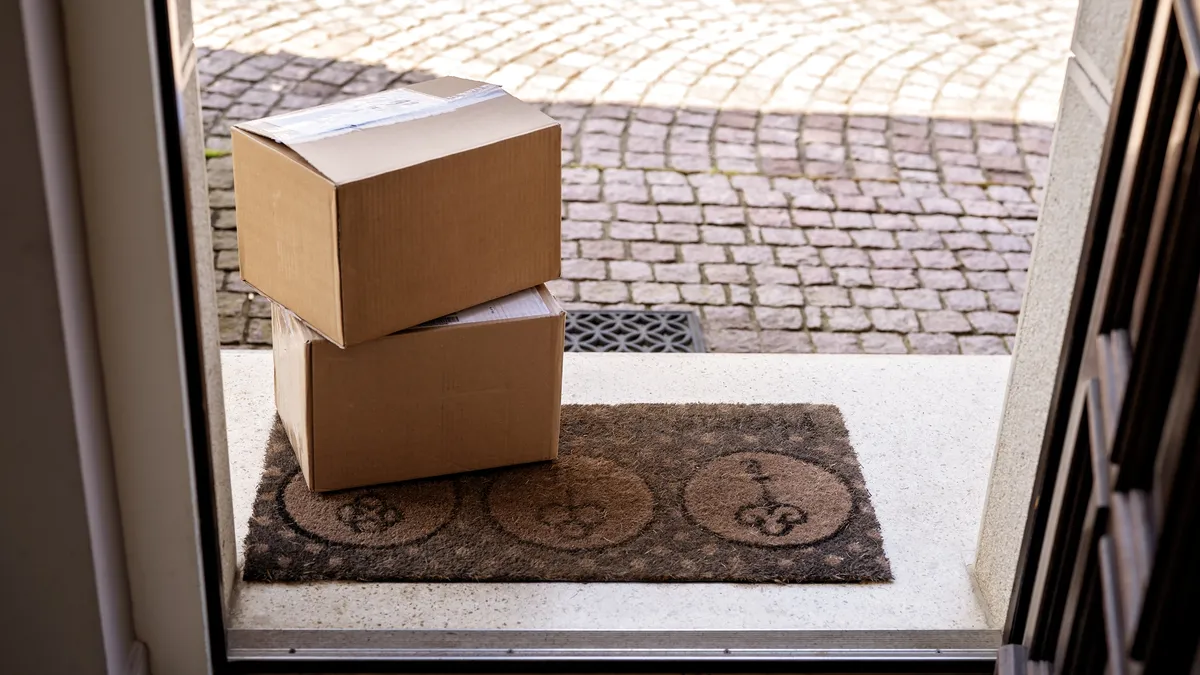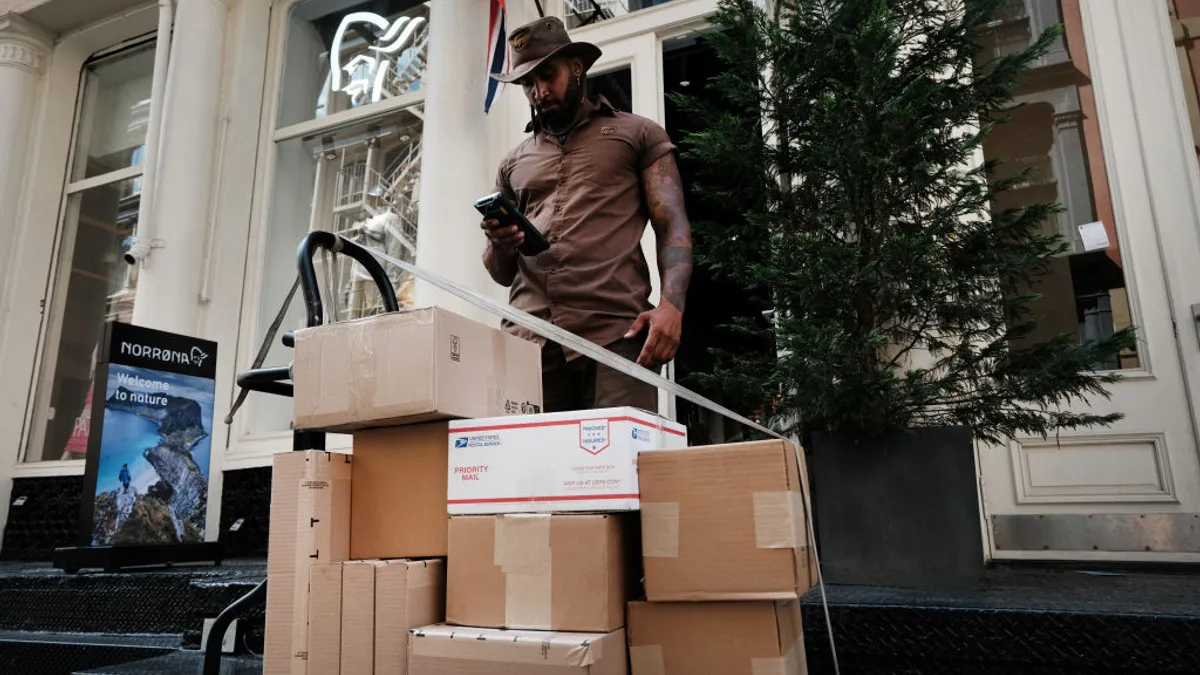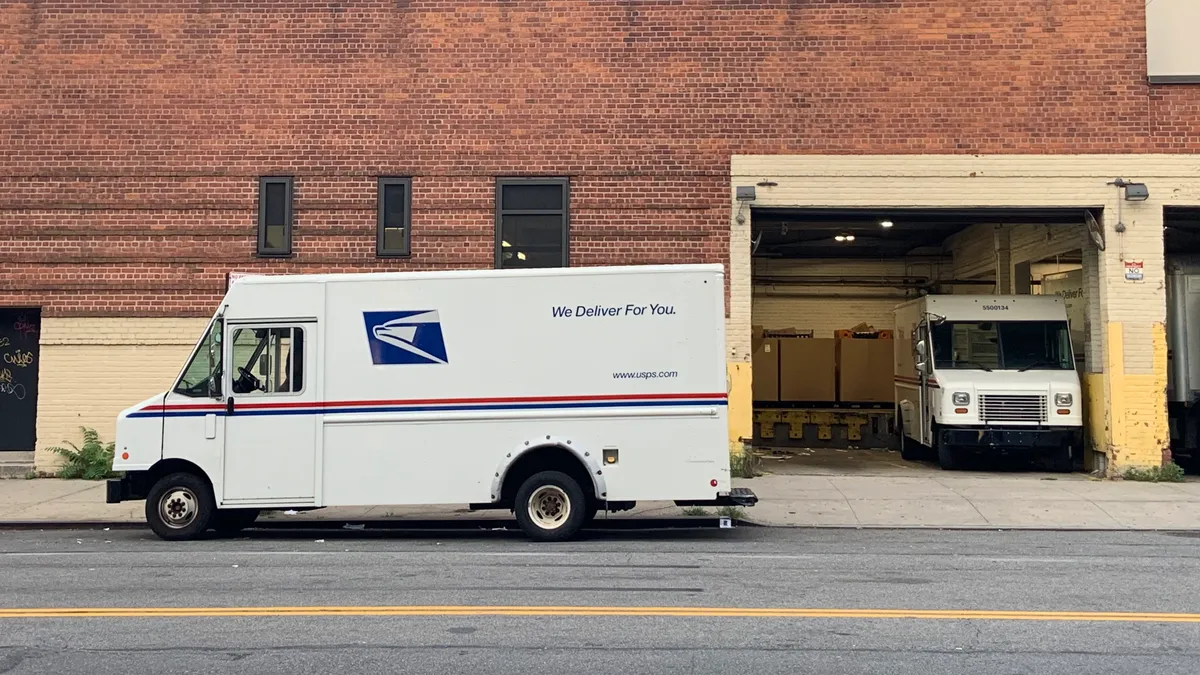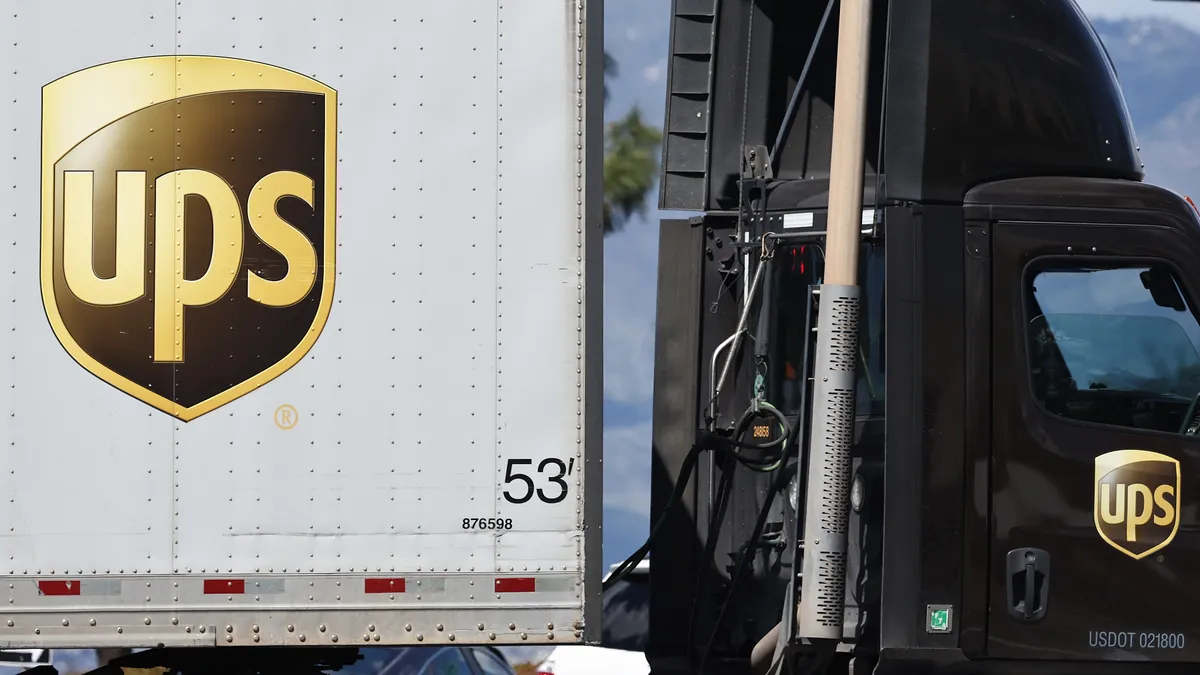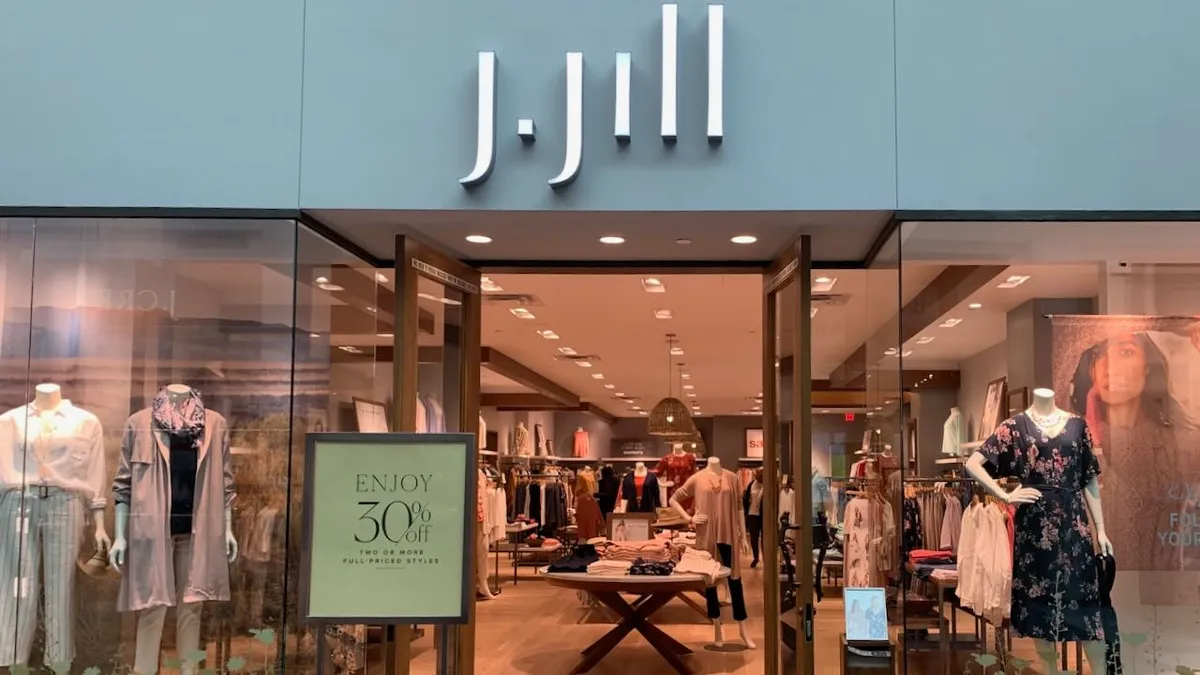OnTrac is booked through peak season. The regional carrier headquartered near Phoenix started to see peak-level volumes in the spring, said Mark Magill, vice president of business development at OnTrac.
"Boy, did the spigots open during April," Magill said. Major retailers approached the carrier with parcel volume — so much that OnTrac made the decision to stop taking on new customers in August. "We're maxed out now too," Magill said. "We had to say, 'January will be a very good day for you to ship with us.'"
OnTrac's story is a familiar one. Multiple carriers and parcel consultants told Supply Chain Dive a similar narrative of shipper demand for regional services after UPS and FedEx began limiting volume.
"They're being capped by UPS and FedEx. And they're stuck," said Millie Tarallo, vice president of sales and marketing at GLS, formerly GSO, a regional carrier based in California.
Josh Dinneen, chief commercial officer at LaserShip, said this is the first time in his 18 years at LaserShip that retailers told him the national carriers suggested shippers find a different logistics provider for shipments
"They're being extremely stringent on retailers in a way that we've never seen before," he said, referring to UPS and FedEx.
"They're being capped by UPS and FedEx. And they're stuck "

Millie Tarallo
Vice president of sales and marketing at GLS
Many shippers were already working with regionals, but the volume caps pushed big-box retailers and global companies in droves to regional parcel carriers such as OnTrac in the West, LSO in the Southwest, United Delivery Service in the Midwest and LaserShip on the East Coast as supplements to their existing last-mile capacity.
These alternatives to UPS and FedEx have brought on major retailers over the last several years, with expansion accelerating during the COVID-19 pandemic and resulting parcel boom — and experts say the growth of regional parcel carriers will continue beyond peak season 2020 and the pandemic.
Mapping the regional parcel carriers
Diversifying the duopoly
Walmart reportedly started tapping into regionals four years ago. Kohl's lists OnTrac, UPS, FedEx and USPS on its website. So does Best Buy, with the addition of LSO. Ulta Beauty said in a May tweet it works "with multiple shipping companies including UPS, USPS, OnTrac, LaserShip, United Delivery Service, and International Bridge."
Still, regional parcel carriers make up only about 6% to 8% of the overall U.S. parcel market, said Rob Martinez, founder of Shipware. The private companies' combined revenue is an estimated $5 billion to $6 billion, compared to UPS' 2019 package operations revenue of $61 billion.
Parcel shippers have lamented the lack of competition in the delivery market. In Parcel's 2019 carrier performance survey of 150 shippers (mostly retail, manufacturing and wholesale/distribution), 65% of respondents said there wasn't enough competition in parcel delivery to keep pricing reasonable and service levels high.
The survey also showed increases in the number of shippers using regionals, indicating the trend to diversify was picking up pre-pandemic.
"And COVID just really put that on steroids," Tarallo said of the shift to regional carriers.
Shippers turn to alternative parcel carriers
Retailers contacting Lasership in the early days of the pandemic expressed disappointment with their national carriers' service levels. Both carriers suspended service guarantees in the spring. On-time performance dropped in May, though it remained in the 90s, according to ShipMatrix.
Then, volume caps made diversification a necessity.
As a result, the regional carriers have "gained hugely" in B2C, said Juan Sotolongo, founding partner at 722 Consulting and a former director at UPS. "The major carriers are using them as service saviors as they are stressed by capacity constraints." Neither UPS nor FedEx responded to Supply Chain Dive's questions about regional parcel carriers and the relationship to their businesses.
How to decide if regional is the way to go
Choosing to go regional is not a one-size-fits-all approach, parcel experts said.
"It really depends on the delivery objective, the price of shipping in relation to overall product price sold, and promised timeline to determine whether a regional carrier's services are right for the merchant and consumer," said Krish Iyer, head of industry relations and strategic partnerships at ShipStation.
Shippers with customers concentrated in a specific market are "prime candidates" for using regional parcel carriers, Martinez said. So are retailers investing in multi-carrier software.
Nate Skiver, founder of consulting firm LPF Spend Management, said shippers exploring the use of regional carriers should first "take a step back and review." Look at volume by origin and distribution center to determine if there are opportunities for volume to shift. And if there's enough volume to move, review which carriers operate in which regions. Shippers can reach out to their peers and understand how fellow retailers are using regionals in their network, Skiver said.
Parcel carriers available in each state
| State | Regional carriers |
|---|
"Regional parcel carriers are gaining in popularity because of their sound delivery promise," Iyer said — a necessity for smaller or lesser-known brands to retain customers over established logistics players.
Skiver pointed out UDS and OnTrac as delivering consistently, high levels of service within a "very specific footprint."
Regionals can offer faster delivery and earlier or later pickup times because of their concentration in niche areas. On-time delivery is also critical for a carrier like GLS that ships several pharmaceutical and medical products.
But not all shippers have reaped the service benefits. A Shipware survey asked regional parcel carriers the most common objections they hear from prospective customers, and the top response was "previous poor service experience," Martinez said, adding that FedEx and UPS on-time rates are typically in the high 90s.
In many cases, rates for shippers using regionals are lower than with national carriers. "That's the major reason people come to us," Magill said. He said OnTrac can reduce rates by 20% "if you're a giant UPS or FedEx ground shipper."
Martinez said regional carriers can range from 10% to 40% less expensive than UPS and FedEx.
But even the regional carriers enacted peak surcharges this year to cover additional costs — though the fees did not begin as early, nor are they as high, as the surcharges implemented by UPS and FedEx.
Shippers are frustrated with cost, pricing from parcel carriers
Shippers are often hesitant to mix up their carrier base with regional providers, Skiver said. That's because they're an unknown entity, which puts the regionals at a disadvantage when competing for customers. He described the regionals' path as an "uphill climb."
There's a greater risk of bankruptcy in the regional carrier market than with UPS or FedEx. "Northeast shippers were caught unaware when Dicom/Eastern Connection shuttered its business without warning in 2019," Martinez said.
"If volume falls below a certain threshold, shippers could lose all discounts."

Rob Martinez
Founder of Shipware
Diverting volume could also affect pricing and contracts with UPS and FedEx, according to consultants.
"If volume decreases, incentives decrease," Martinez said, due to the logistics providers' revenue-based tiers for pricing. "In fact, if volume falls below a certain threshold, shippers could lose all discounts."
Can the regionals scale?
Among shippers' chief concerns with regionals is the ability to scale up and handle volume surges.
"Historically they have not had the level of management depth required for such growth," Sotolongo said.
The regionals insist they've been building their networks, adding capacity and automation to improve throughput.
GLS, before COVID-19, added automation equipment to increase the number of parcels for sortation at its depots from 2,000 to 5,000 hourly, and with the ability to scale up to 10,000 per hour, according to Tarallo.
OnTrac opened a 183,000-square-foot automated facility in Reno, Nevada in February to expand next-day delivery, and LaserShip added a 40,000-square-foot facility in Durham, North Carolina, in September that can process 14,000 parcels hourly.
Many regionals are also focused on route optimization to maximize density and minimize empty miles.
In a side by side comparison of automation and shipment tracking, FedEx and UPS still come out ahead of regional carriers, said Skiver. "Doesn't mean they're deficient," he said of regional carriers, adding that what matters is whether the technology suits individual shippers' needs.
Some e-commerce focused regionals, such as LaserShip and OnTrac, touted the advantage of their networks designed for residential deliveries. They didn't need to adjust operations to accommodate a shift from B2B to B2C like UPS and FedEx.
OnTrac's parcel split before the pandemic was around 85% residential. LaserShip didn't give an exact figure but said it was predominantly residential.
"When the volume came, we just achieved scale," Dinneen said.
"There's room for more players in the marketplace."

Mark Magill
Vice president of business development at OnTrac
Shippers won't abandon ship at UPS and FedEx anytime soon — if ever. But they are increasingly using regionals and will continue to do so unless service levels or pricing take a turn for the worst. Market projections indicate there will be more parcel volume to go around, and a need for shippers to diversify carrier networks to accommodate for the growing number of packages traversing the U.S. each day.
"They're fine companies," Magill said in reference to UPS and FedEx. "God bless them. But there's room for more players in the marketplace."



